 i iThe Howe Enterprise Thursday, May 31, 1973 pg. 1 AUTHOR REVIEWS HISTORY OF HOWE, CELTIC COMMUNITY Gentlemen: Enclosed is summary of "Memories Heaven Tall" about David Archibald Harrell and the community of Celtic and Howe. I am hopeful you will print all or part of this story and if you do, will you send both Martha Harrell Connor and the writer a copy of your paper...Mrs. Connor is one generation older than my generation and it is so interesting that so much development was accomplished in twenty-plus years before my arrival....I went to Howe schools... Sincerely, Mrs. Fred Brown By Mrs. Fred Brown Excerpts from "Memories Heaven Tall" by Martha Harrell Connor, daughter of David Archibald "Archie" Harrell (1862-1940) and Carrie Hickox (1860-1935), granddaughter of David Jackson (1827-1900) and Narcissa Ellen Poindexter Harrell (1841 - 1968): Father was the son of David Jackson Harrell and Narcissa Poindexter. He was born with a nickname "Bub" given him by his sisters and brother. Born in Joplin, Missouri, Dade County, in 1861. His maternal grandparents were Archibald Harrell (1805-1892) and Delilah Jones (1812-1881), both buried at White Mound Cemetery, near Tom Bean, Grayson County, Texas. Archibald Harrell owned 40 acres in Springfield, Dade County, Missouri in 1858. By mid-summer 1870 the couple were living in Oak Grove, Oregon County, Missouri, returning to Dade County and residing at Rock Prairie at the time of the 1880 census, June 28, 1880. They moved to Grayson County, Texas a few months later, before Delilah's death April 2, 1881. My grandfather, David Jackson Harrell, went to California and found all the gold he could bring home and $10,000 in money. He wanted this to give to his grandchildren. He had so much gold that he stuffed it in his shirt pockets and pants as well as in a money belt worn around his waist. He was afraid to travel home to Joplin over land so he came back by way of boat around Cape Horn. His wife died when my father was 6 years old and left 4 children from 8 months to 10 years old. David Jackson & Narcissa Harrell are buried in Whitemound Cemetery near Tom Bean, Grayson County, Texas. Grandfather left Missouri in a covered wagon to find land to homestead. He stopped when he got to Grayson County, Texas. He chose the river bank on the north. He has ample holdings to build a stout log cabin at White Mound. It became the Celtic Community. The community grew and a school and Church of Christ was established. Neighboring homesteaders helped to swell the school and church. This was indicative of the end of the Civil War and people were coming west. My father attended the home school but aptitudes leaned towards nature's gift to man. (1880 Precinct #3, Grayson Co., Texas - living with father & two siblings). He had to satisfy this urge for it was consuming him. He wanted to file for land and make his own life. He went to his sisters, Mary and Nancy Orleana, and brother, Willis, and they gave him solace for the complexities he would face. Time grew longer and the nights restless in introspection. He was 18 years old now and he felt he was old enough to make his own decisions. Old enough to think things through to a logical conclusion. His work would entail long hours of untiring and unstinting sacrifice of hard work of which he was capable. He mused, "he would abide by his mistakes and profit by them" accountable only to himself. When dawn came he knew that was the day he would make his move. A move that was to change his life. He knew also when he left that all endearment from the grandfather and father could never be cemented again. He became wholly committed to a bold life. In a way a belligerent liberal as far as the grandfather was concerned. Now the door was closed between them, and he never again gained his good graces. Today his head was held high, his shoulders erect, and his feet well planted in the sod. His eyes on the road ahead. This was the richest black earth he had ever seen. He pushed a clump with the toe of his shoe and it disintegrated. He picked up some and let it sift through his fingers, returning to earth. This soil and its composing elements that gave it life will serve me well. His mind was filled with wonderment as he scanned this priceless gift of nature offered to him. All the vast fertile, virgin soil. The trees he reasoned are beautiful and they are here for a reason. I shall hew them from the river banks and woods and they will be the making of a home. That resolved the difficulty in providing a cabin. Knowing full well he had the ability to cope with nature; his mind turned to his own safety. He was now ready to take his place as one of the Founding Fathers of Grayson County, Texas. Land was given from 1865 to 1893. He was given 50 acres for clearing it of cocklebur, tumble weeds and Johnson grass. The grass has long deep roots and was burned off and then turned under by deep plowing. In 1893 there was no more free land. Many Negroes had small blocks of land and established a homestead of their own. With 50 acres under the Home Act, he got to work. Negroes came for work. Soon the place was taking shape. They built a two room log cabin, joined forces with a newly made friend, Wampy Holtzman, who helped in the building. Pine trees were used. The cedar logs were split for the walls (on a hot day, dripped of rosin). Pine logs were used for the foundation. These were termite repellent so they learned in later years. Small huts were built to house the workers. It did not take long to learn that the 10 feet deep creek was the answer to a prayer (possibly Sister Grove Creek). He saw coming from the rock on one side of the bank, crystal clear fresh spring water. This meant the creek was spring fed and it came down stair steps of rock forming a bowl in the side of the rock. This meant cold fresh drinking water the year round. The water tumbling over made a natural fishing hole a little way down the creek. It was always filled with trout. Along the river bed was a swimming hole that became a luxury. The woods were alive with wild turkey and game. The crab apple which is very tasty; persimmons, blackberries, and pecans were plentiful. The scrub oak, black hull and hickory trees were cut down with other waste brush. Thus food was as fire, as free as the air and a great boon. Just 4 miles away was a little cross-roads village of Howe. Howe was primarily a one street town. Main street extended for a mile in each direction and disappeared in the distant haze of Johnson grass, tumble weed and cocklebur. Father became well acquainted in this little town. Getting word from beyond the fields and wooded pasture was accomplished by mouth. In later years, a paper, the Howe Herald, was produced. In still alter years, Mother wrote a weekly column for the paper. The merchants now established a grocery store, feed store, and post office. Hardware that was needed was brought from Sherman. A strong tie was developed with the merchants. They thought Mr. Harrell showed thoughtfulness and courtesy. With his life's savings, which he took with him, he was to get essentials. This meant seed for the crops, a plough and a couple of dray horses. He was able to borrow from them - using his coming crop as collateral. The merchants liked his sound principle and amiability. He became a quick and skilled amateur in raising cotton and corn. Years later he also raised cattle. The land took shape, and the money he brought with him and that he borrowed paid his debts and bought more land. By now he knew freedom from mistakes came with the right reasoning. Now that the fields were in full production, it was time for the next step along life's way. In his heart he carried the imprint of a plantation home. He had only to let it materialize. The pangs of loneliness enveloped him. Like a magnet he kept going back to Carrie. Carrie, whom he met at school and they had fallen in love. She was the daughter of Asa Richard Hickox (1828-1897, a Revolutionary soldier) and Mary Jane Wilhite Hickox (1832-1915). His log cabin stands today as a landmark at White Mound, Texas. A descendant from Warwickshire, England came over in 1635. His thoughts of Carrie gave him a fresh source of strength. She not only gave him love but understanding. The decision was made to build the home now. The plans called for one section of land. It would accommodate the home orchard, animal shelters, barn and work shop. The next day they started laying the foundation. The ground was high and imposing. The home was two storied. The roof formed a gable style at each end. A long porch went from the front to the back. It had a banister with little spokes beneath. The house contained 7 bedrooms and one large bath. The servant quarters was a 3 room and bath. A large screened in back porch became the family living room. The home finished, the next step was marriage. Surely Carrie's blood would enrich the family tree. He took his new bride to enjoy the benefits of his new home. She was a tremendous asset and proved it in many ways. Six children were born to them that lived to know the pioneer's life. Mother learned the skills through the years that kept the family in good health. Her father died at the end of the Civil War. The loyal support of the Confederacy had left them in dire circumstances. There was nothing left but broken dreams and bitter memories. Two sons were born to David and Carrie, who died in infancy and are buried at White Mound Cemetery, Richard R. Harold and George Earl Harrell. Education was a daily topic, Father thought. No lacking qualities could keep us from progress if we applied our energy rightfully. Our aptitudes needed only determination and the old stick-to-it-iveness. According to the 1900 census, David and Carrie were living in Precinct 4 of Grayson county with their five children: Mary, 11; Ray, 10; Annie, 7; Mattie, 4; and Gutie, 2; as well as Carrie's mother, Mary Hickok; and Ida Faubion, servant; and boarders, Ben Epton, Charley Stalcup, occupation farm laborers. In 1910 the Harrell family lived on the Howe-Sherman Road: David and Carrie; children: Annie, Mattie, Horace, and Dallas along with Carrie's mother, Mary Hickox. 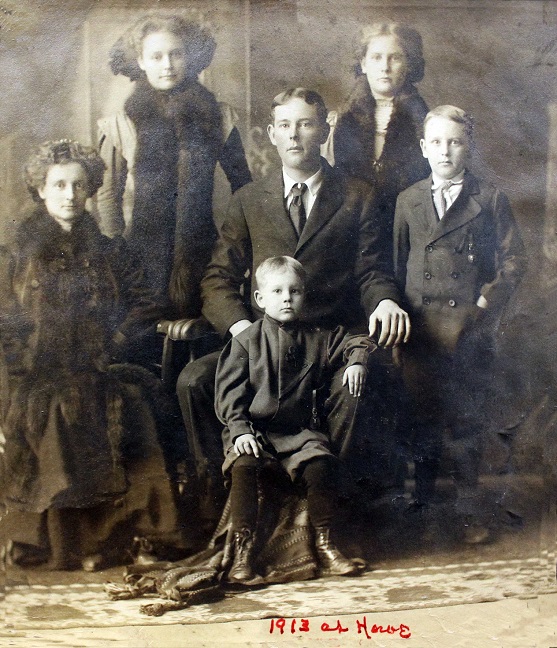 David A. & Carrie Harrell family 1913 at Howe Contributed by Melissa E Connor The little town of Howe could now support a high school. It was adequately designed to support a population of 500. The Interurban ran from Dallas, McKinney, Van Alstyne, Sherman and Denison. I was the mainstay that kept that bus on wheels. Dad helped build the school. He built a home for the principal, stalls for the horses, and a long hitching post. Father had the urge for the plains of the Panhandle. Progress marked well his path as an early settler of this West Texas empire. He left Grayson County and his indomitable Carrie joined him on the range in Carson County. By 1920 David Harrell was a "ranch man at Claude, Texas" although his family was enumerated as still still living at 1310 S. Crockett Street in Sherman; he was 56 and she was 54 years of age. Living in the house were their 31-year-old daughter, May Orleana, son, Hollace W., 26, son, Dallas A., 14, as well as two granddaughters, Margarite and May Etta George, ages 7 and 8. 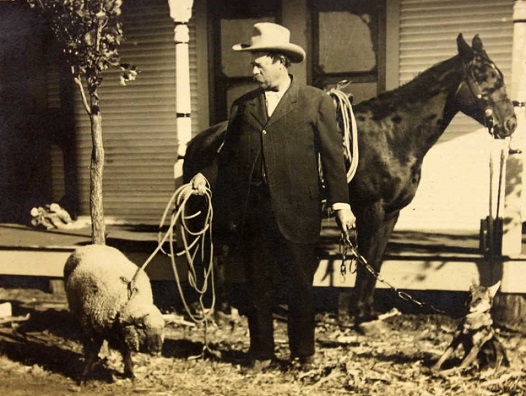 Claude was the county seat of the Panhandle county of Armstrong. However, David appears to have been residing on Dysart St. in Claude on January 3, 1920 along with his daughter Mary Orleana and her three children; boarding in the house are four public school teachers. David is listed a retired "capitalist". (1920 census, Claude, Armstrong County, Texas) 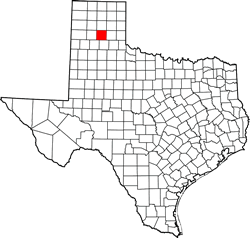 They helped the common people to self help - to get their share of the good life. Father built a home in this quiet prairie. Meeting the challenge of stillness, broken only by coyotes baying at the moon at night. We deemed to get closer to God in this peacefulness. This was their resting place. 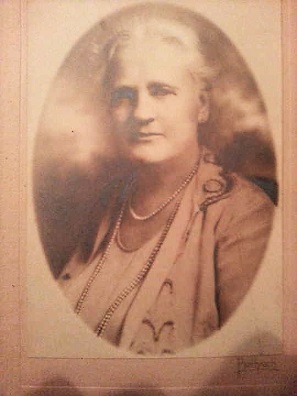 Mary Caroline "Carrie" Hickox Harrell Both David A. and Carrie
Harrell are buried in Claude Cemetery, Claude, Armstrong County, Texas.
(Find-A-Grave Memorial #142415736 and #142415762) 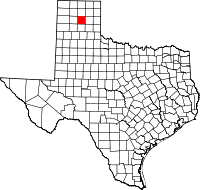 Howe History Susan Hawkins © 2024 If you find any of Grayson CountyTXGenWeb links inoperable, please send me a message. |